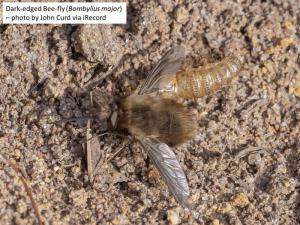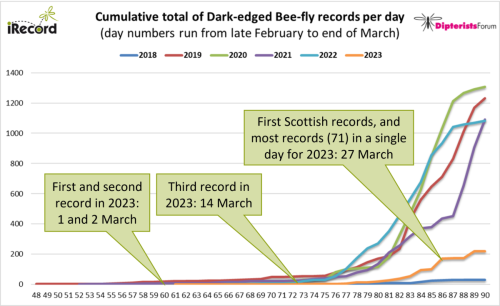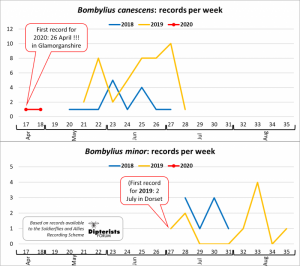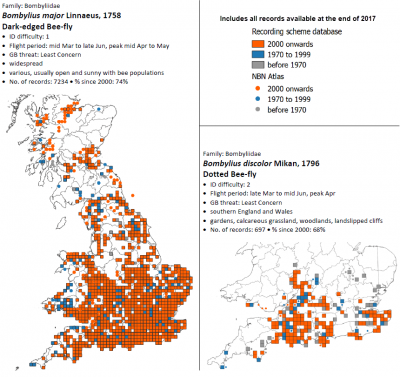Bee-fly Watch: latest results
 Here are the latest reports from #BeeFlyWatch, covering the two spring bee-flies, Dark-edged Bee-fly (Bombylius major) and Dotted Bee-fly (Bombylius discolor), and later on the two summer bee-flies, Western Bee-fly (Bombylius canescens) and the very rare Heath Bee-fly (Bombylius minor).
Here are the latest reports from #BeeFlyWatch, covering the two spring bee-flies, Dark-edged Bee-fly (Bombylius major) and Dotted Bee-fly (Bombylius discolor), and later on the two summer bee-flies, Western Bee-fly (Bombylius canescens) and the very rare Heath Bee-fly (Bombylius minor).
Bee-flies in 2023: the first bee-fly of 2023 has been seen! Mo Richard reported one in North Wales on 1 March, and John Curd found a freshly-emerged male in Bedfordshire on 2 March, both reported via iRecord (see John's photo on the right). We then had to wait until 14 March before the third record for the year appeared. The earliest ever record of a Dark-edged Bee-fly was on 9 February (in 2022), and there have been a few other February records in recent years, but numbers usually build up through March, depending on weather conditions. The earliest ever date in Scotland is 16 March, and in 2023 the first Scottish records were on 27 March. Here is the progress for Dark-edged Bee-fly up to the end of March 2023:
And here is a summary of flight times for both spring species in 2018-2021:
As further records for 2023 are added to iRecord you'll be able to keep track of them here (or go to the iRecord activity page):
Bee-flies in 2022: over 3,500 records of the four Bombylius bee-flies were contributed in 2022, from well over 1,000 people - thank you. Sue Taylor topped the list of contributors with 84 records, but all records are appreciated, even if you only sent in one! No one person saw all four Bombylius species in 2022, but four people managed to see three of the species.
A summary of records and some of the photos sent in during 2022 can be seen here.
Here's the spread of records across the country up to 5 April in 2020 (watch on YouTube to see at full size):
Here are the flight periods two summer-flying bee-fly species in 2017 and 2018. Click on the image for larger size:
Bee-fly Watch started in 2016, and has been successful in greatly increasing the number of records of these insects. Before the project started the recording scheme was rarely receiving more than 150 records of Dark-edged Bee-fly per year, but this has rapidly risen to an amazing total of well over 2,000 records in 2019 and over 3,000 in 2020 and 2021 – a big thank you to everyone who has taken part:
With the increased number of records we can start to see some fascinating changes in the flight periods from year to year. In 2016 the flight period for the Dark-edged Bee-fly was quite extended, with a low peak in mid-April. In 2017 warm weather early on meant that the flight period started very early, peaked in early April and ended earlier as well. In 2018 it was a later start again, with a very sharp peak in mid-April and a scattering of records into late June. In 2019 our first two records were the earliest ever, on 17 February (in Sussex and Surrey), and this led to a very early, and very high, peak in March. The same early peak was echoed in the Dotted Bee-fly, although with fewer records. Although there were no especially early sightings in 2020, once the season started in March it quickly reached a high peak in the first half of April. There were some February records again in 2021, but with more mixed weather the peak was lower.
The end of the flight period is harder to define. We often get reports into July and August but usually without photos and they cannot be confirmed. If you see a bee-fly after mid-June please do try to get a photo, as we know that some reports from late in the season have turned out to be Humming-bird Hawk-moths or other misidentifications.
The Dark-edged Bee-fly has always been widely distributed in Britain, with the Dotted Bee-fly more restricted to the south-west, but there is evidence of a spread for Dotted Bee-fly in recent years. In 2019 there were new vice-county records for Staffordshire (from Thomas Woodhall and Lukas Large) and amazingly in Leicestershire (Alexandra Wallace-Hicks). In Surrey Ryan Mitchell had the first fully confirmed record for the county since 1964 (following a probable but unconfirmed sighting in 2015). Dotted Bee-fly continues to expand, with new records for Bedfordshire in 2020.
The maps below (from the recording scheme atlas) show all records up to the end of 2017. More recent records can be seen via the NBN Atlas pages for Bombylius major and Bombylius discolor.



